There are no easy paths to New York City as a Heisman Trophy finalist, but there are a variety of them. The four college football quarterbacks who will be there Saturday night for the awarding of the most prestigious individual honor in sports arrived via four distinctly different routes.
Some are more romantic and unlikely, others you could see coming. Whiz kids and late bloomers, can’t-miss prodigies and off-radar underdogs, they occasionally can all arrive at the same place. That’s part of the beauty of sports, and of life in general.
So when you tune in and see four young men, extremely confident on the field and assuredly nervous in that moment, appreciate what it took for them to get there. Talent plus sacrifice plus determination plus belief plus familial and community support form a common set of characteristics for a quartet of unique and diverse players.
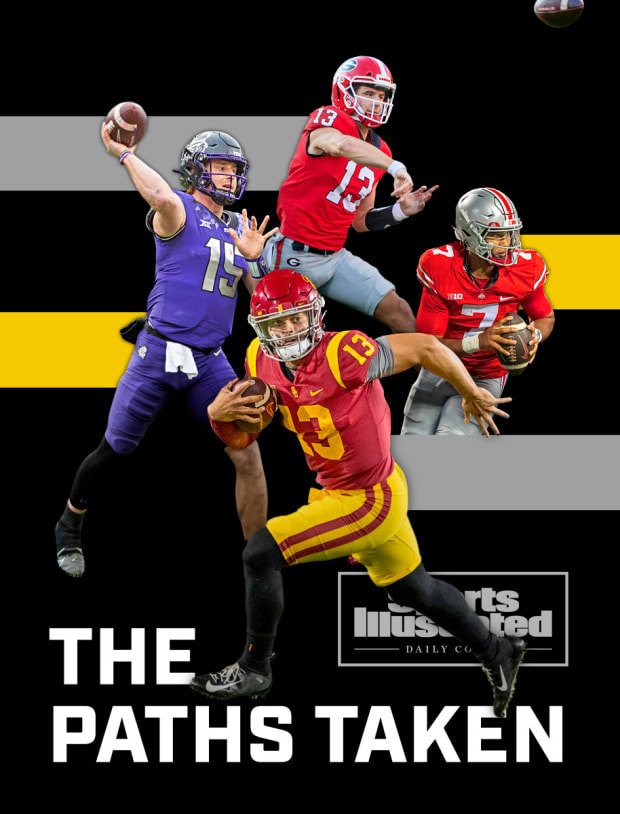
Greg Nelson/Sports Illustrated (TCU); Carlos M. Saavedra/Sports Illustrated (Georgia); Erick W. Rasco/Sports Illustrated (Ohio State); John W. McDonough/Sports Illustrated (USC)
Caleb Williams: The Chosen One
For USC’s Williams, this was part of a business plan put together with spreadsheets and high ambitions from a young age. A precocious athlete at 12, he said he wanted to be a quarterback. His father, Carl, set a course for his son to be not just a QB, but a superstar QB. “He put together a plan,” Williams wrote in a blog for Sports Illustrated while still in high school in Washington, D.C. “Not just a football and working-out plan—a meal plan, schedule, social and all of that.”
By eighth grade, Williams was making the rounds on the national quarterback camp circuit. For four straight years, he attended the QB Collective, which was staffed by coaches and players with professional experience and designed to build NFL skills. With Williams, it was love at first sight.
“We knew in eighth grade he was going to be a five-star recruit,” says former NFL QB Sage Rosenfels, who worked with Williams at QB Collective. “There was something different about him from all the other kids we had—the natural throwing motion and the way he can really fire the football, but more than that. It’s almost like he just knew he was going to be at one of the top colleges and then play in the NFL. His dad had a plan, and every decision was based on how to maximize his career.”
That sequence of decisions led, rather logically, to Lincoln Riley. Then the coach at Oklahoma, Riley had two players do exactly what Williams dreamed of doing—winning the Heisman Trophy in the winter and being the No. 1 NFL draft pick the following spring. First it was Baker Mayfield, then it was Kyler Murray. And by the time Williams was being recruited as the No. 1 prospect in the class of 2021, Jalen Hurts had transferred in from Alabama and become a Heisman finalist.
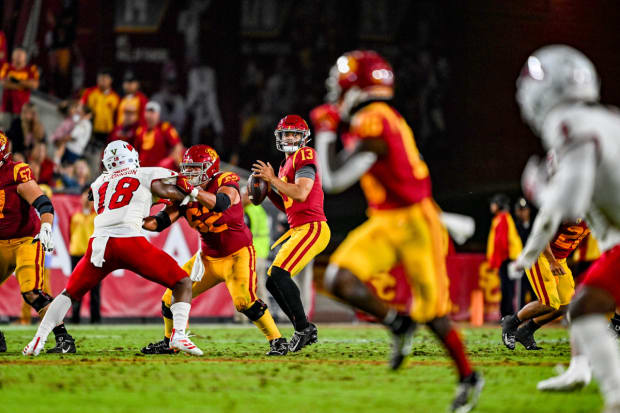
John W. McDonough/Sports Illustrated
Williams’s order: I’ll have what they’re having.
After naming five finalists in March 2020—Clemson, LSU, Maryland, Oklahoma and Penn State—Williams announced his commitment to the Sooners on the Fourth of July. He enrolled early, in January ’21, undeterred by the presence of returning starter (and the presumptive next Oklahoma Heisman winner) in Spencer Rattler. Williams came with the modern trappings of teenage stardom—an agent and PR support—but also with commensurate ability and drive.
When Rattler was rattled by a slow start and home field jeers, Williams was ready to assume his inevitable place as Oklahoma’s starter and star. He led a wild comeback to beat rival Texas. He saved the Sooners from an ignominious defeat against Kansas with a brassy freelance play, ripping the ball from his own stymied running back and carrying it for a key first down. But there were struggles in the final three games of the regular season, two of them losses, to remind everyone that even prodigies have a learning curve.
Rattler knew what was coming and transferred to South Carolina. But then Riley threw Williams a curve, stunningly making his own relocation to USC. With The Plan hitched to Riley, Williams followed—and a flotilla of skill-position talent from all over the map joined him. Neither the coach nor quarterback will ever be forgiven in Oklahoma, but they have become instant heroes in Southern California.
The result was the rapid rebirth of a blueblood. USC went from 4–8 to 11–2, and Williams became everything Mayfield and Murray were under Riley: productive, creative and elusive. In 2017, Mayfield led the nation and set the NCAA FBS record (since broken) for highest pass-efficiency rating (198.92). In ’18, Murray finished second nationally in efficiency. In ’19, Hurts was second. Williams currently ranks fifth, perhaps with a bowl game to go.
It all depends on his recovery from a hamstring pull during one of his most sensational plays of the season in last week’s Pac-12 championship game. The 6'1", 215-pound Williams took off on a scramble against Utah, breaking three tackles and executing two sharp cutbacks to cover 59 yards—but he slid to a halt inside the 10-yard line after feeling the hammy stretch like “an old rubber band.” He wasn’t the same for the rest of the game, which ended in a 47–24 defeat that cost USC a College Football Playoff bid, but limped his way through it.
“He wouldn’t let me take him out,” Riley said after the game. “S---, that was one of the gutsiest performances you’ll ever see.”
Williams is the most likely of the four finalists to hear his name called Saturday as the Heisman winner. But the lopsided loss in that game may have loosened his lock on the award, and there are some who are turned off by his series of what could be termed “F-U” manicures directed at opponents. But if that’s enough to change your vote, it’s clearly proof the Heisman has devolved into more of a statesmanship award than honoring the best college player in the country.
Williams is still nearly 18 months away from the next stage of his plan, which is being an NFL draft pick. The time could give him a chance to be just the second repeat Heisman winner, which has proven more elusive than it probably should be since Archie Griffin did it in 1974 and ’75. Last year’s winner, Alabama quarterback Bryce Young, isn’t a finalist this time.
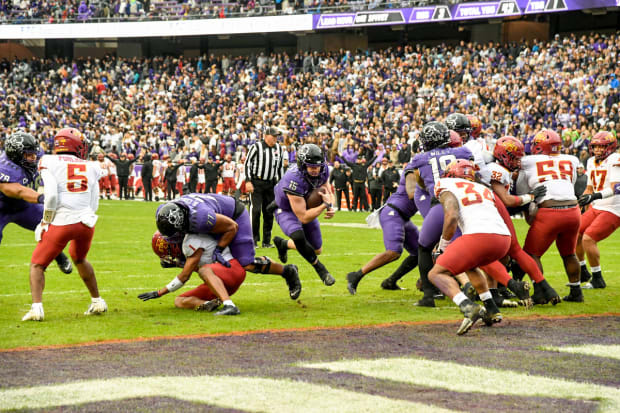
Greg Nelson/Sports Illustrated
Max Duggan: The Backup Who Burst Onto the Scene
Late in the third quarter at Colorado’s Folsom Field on the season-opening night of Sept. 2, TCU starting quarterback Chandler Morris hurt his left knee on a run. In came backup Max Duggan on the next possession, and the course of Horned Frogs history changed.
On his first play of the season, Duggan took off on a 33-yard run. Over the next several plays, he accounted for 33 more yards running and passing on a touchdown drive that broke the game open. Morris was out the next couple of games with his injury, and by the time he was ready to return, he had been Wally Pipped. Duggan was the man who would take TCU to a 12–1 season, the Big 12 championship game and the Playoff.
This raises a question: Has a Heisman winner ever started the season as a backup? And that raises a second question: Why on earth was Max Duggan a backup?
The questions have been asked a lot by those who knew Duggan back home in Council Bluffs, Iowa. They suspected he was subject to the New Coach in Town dynamic, with first-year leader Sonny Dykes elevating the 2021 backup (Morris) at the expense of a player who had compiled more than 7,300 yards of total offense at TCU while starting most of the previous three seasons.
“Knowing how Max can step into a huddle and command the respect of a team, it blew my mind,” says Justin Kammrad, who was Duggan’s offensive coordinator at Lewis Central High School and is now the head coach. “How can you go in a different direction? I was shocked; I was surprised, but I knew Max would handle it. He’s a coach’s kid.”
Then-head coach Jim Duggan made his son the starter at Lewis Central as a freshman, which invited charges of favoritism. But the kid justified his playing time over the next few years by becoming one of the better quarterbacks in the country and sparking a spirited recruitment.
Iowa State and Iowa were first in the door, naturally, but Duggan had his gaze set beyond the state borders. Nebraska was nearby, but the coaching change from Mike Riley to Scott Frost pushed the Cornhuskers down the ladder. From the summer of 2017 into early ’18, offers poured in from across the nation—including Georgia, Penn State, Ohio State, Oregon and his childhood favorite, Notre Dame.
But in the middle of the blueblood push, TCU—and in particular then offensive coordinator Sonny Cumbie—made an impression on Duggan. After visiting the campus in March of his junior year, he committed in April and never wavered. It didn’t make sense geographically, but the fit was legit.

“He wanted to blaze his own path,” Kammrad says.
As in high school, Duggan jumped into the fray as a freshman starter, but team success was elusive as the Gary Patterson Era flattened out—TCU was 16–18 over Patterson’s final three seasons, which were Duggan’s first three. It was time for a change, and the school swiped Dykes from the other side of the Dallas–Fort Worth Metroplex at SMU.
Dykes brought his offensive coordinator with him—Garrett Riley, Lincoln’s little brother. They opened the quarterback competition in spring practice and arrived at no decision on who would start. Heading into that opener at Colorado, Dykes remained noncommittal on a starter and said the Frogs would play as many as three QBs in the game, with freshman Sam Jackson joining Morris and Duggan in the rotation.
It all turned out to be posturing—Morris was the guy, right up until the injury that let Duggan regain a role he never again relinquished. What followed has been the stuff of TCU legend. Duggan is in the top 10 nationally in pass efficiency and top 15 in total offense yards per play, and he might well be the national leader in clutch plays in tight games. There were many this season for the cardiac Frogs. His finest moments:
- Two drives late against Baylor, in which the Horned Frogs covered a total of 136 yards to score nine points and pull out the win by a point on the final play. Duggan ran or passed for 116 of those yards, each of them vital.
- A daring drive against Kansas State in the Big 12 championship game to force overtime—perhaps the final insurance TCU needed to lock down its first Playoff bid. Duggan ran or passed for 90 yards on the drive, including a 40-yard sprint to set up his 8-yard touchdown run on the next play. Then he passed for the tying two-point conversion, and nearly collapsed after the drive.
Those games reinforced Duggan’s elite athleticism, as he ran for more than 1,800 yards combined over four seasons. It’s a talent he inherited from Carl, who played quarterback, and his mother, Deb, who was a standout hurdler. The innate drive to win has been there all along, too.
“His growth at TCU has been amazing, but a lot of the things we are seeing today, we’ve seen for a long time here,” Kammrad says. “He would carry us. The respect from his teammates, the belief they have in him, that was the same here. Those guys are going to keep playing for him, because he was going to keep playing for them.
“For a kid from Council Bluffs to put himself in this [Heisman] position, there is a lot of elation and satisfaction seeing it happen.”
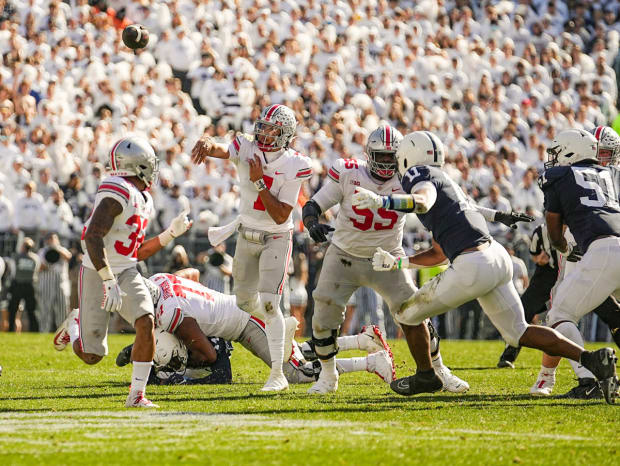
Erick W. Rasco/Sports Illustrated
C.J. Stroud: The Late Bloomer
Colorado was the first. The Buffaloes, coming off yet another losing season, offered a scholarship on Christmas Eve 2018 to C.J. Stroud, who had just finished his junior season at Rancho Cucamonga High School in Southern California. What followed was a succession of similarly modest offers through that winter and early spring.
His first season as a high school starter had gone reasonably well, but the powerhouse programs weren’t interested—they focused more on classmates Bryce Young and D.J. Uiagalelei when they came to scout in SoCal. The five-star guys.
But Stroud exploded on the camp circuit and outplayed more celebrated QBs. Heavyweight coaches began to take note of his arm, release, accuracy and quick feet. And when he followed that up with a blazing start to his senior year, the big boys followed—here came Oregon and Michigan and Georgia. And Ohio State.
With a week left before the December 2019 signing day, Buckeyes coach Ryan Day had a decision to make. He could keep his commitment to appear on the ESPN College Football Awards show the night of Dec. 12, alongside fellow playoff coaches Ed Orgeron of LSU, Dabo Swinney of Clemson and Lincoln Riley of Oklahoma … or he could make a final push in a home visit with Stroud. He made the trip to California to see a kid who didn’t have a single scholarship offer at that time a year earlier.
Day’s trip west resulted in a fine for failing to make the ESPN appearance. It also resulted in landing Stroud, who waited until signing day to reveal his choice. “They could fine us whatever they want,” Day said two months ago, recounting what happened.
At the time, losing out on Stroud was viewed as a big hit for Georgia, which was trying to replace three-year starter Jake Fromm in 2020. As it turned out, the Bulldogs already had the replacement on the roster (but we’ll get to that).
After not throwing a pass his redshirt year at Ohio State, Stroud won the battle to be the starter in 2021 and has been a huge star ever since. His 186.56 efficiency rating that season was the highest ever for a freshman QB, and this year he’s tops in the nation in that department despite leading receiver Jaxon Smith-Njigba being injured and a non-factor virtually all season.
Last year Stroud was one of four finalists for the Heisman. “I’d been dreaming of that moment since I dedicated my life to football,” he said in July. Now he’s the first back-to-back finalist since Lamar Jackson and Mayfield both did it in 2016 and ’17.
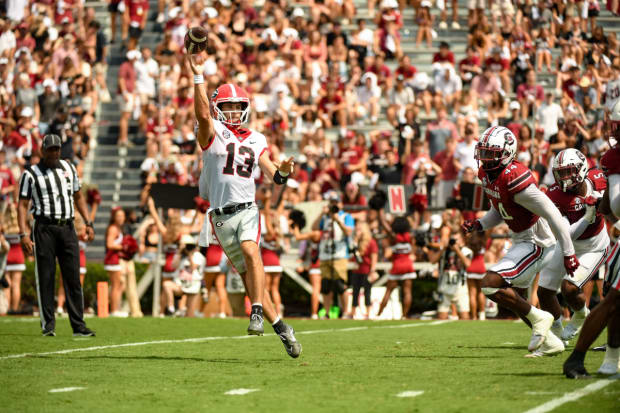
Carlos M. Saavedra/Sports Illustrated
Stetson Bennett IV: The Ultimate Underdog
Denise Bennett remembers the recruiting visit to Georgia, the reception at Sanford Stadium and the moment when her son stepped away from everyone to go look at his field of dreams. He shed quiet tears while staring down between the hedges, overwhelmed that he’d made it that far.
His father, Stetson III, had driven around the South trying to get schools to look at video of his small but athletic son. No takers. With scant interest beyond the likes of Middle Tennessee State and in-state FCS school Mercer, Bennett was thrilled just to get the chance to walk on where he’d always wanted to play.
It was impossible, in that emotional moment in the stadium, to know how much farther he would come.
Bennett’s celebrated walk-on story can be recited by Georgia fans like the lyrics of the fight song. From being assigned half a locker and jersey No. 22 to leaving for junior college after one season buried on the scout team, there was nothing to suggest way back in 2017 that he would become a championship-winning quarterback, statewide folk hero —and, now, a Heisman finalist.
Even after going to juco and being re-recruited as a scholarship player, Bennett had to keep proving himself over and over. Kirby Smart and his staff kept looking for someone better to play quarterback. Bennett kept fighting his way back onto the field, outplaying the competition—and, in one fortuitous twist, avoiding one quality competitor altogether. When Stroud made his decision in December 2019 to go to Ohio State and not Georgia, that was one fewer player Bennett had to beat out.
Last year was the ultimate for Bennett and the Bulldogs. Backed by a historically great defense, the kid from Blackshear, Ga., who told his dad at age 3 he wanted to be the Georgia quarterback, led the Dawgs to their first national championship in 41 years. After being considered little more than a game-manager most of the season, Bennett became a game-winner in the playoff.
He torched Michigan for 313 passing yards and three touchdowns, earning Most Outstanding Offensive Player of the Orange Bowl. Then he led a fourth-quarter comeback to defeat and dethrone nemesis Alabama in the CFP championship game, once again earning offensive MVP honors. What followed was immediate legend status: drinking Pappy straight from the bottle in the team hotel that night; being recognized by star-struck fans in Rome on a school trip; becoming an NIL pitchman for everything from fast food to clothing to sweet onions.
The only thing left to do was run it back for a sixth and final season, and a potential repeat national title. This year Bennett has been more in command than ever, leading a more potent and creative offense. Georgia is 13–0 for the first time, and Bennett is the school’s first top-four Heisman finisher since running back Garrison Hearst was third in 1992.
None other than Aaron Murray, the school’s all-time leading passer, tweeted Saturday that Bennett is “the greatest QB in Georgia history.” Bennett himself is more restrained—but also in possession of a cocksure belief in himself that has withstood so many critics and critiques over the years.
“I’ve got good players around me,” Bennett said Saturday night after winning the SEC championship. “And I’m not that bad at football, either.”







